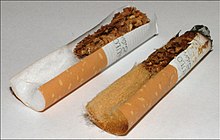Cellulose acetate
Cellulose acetate is a type of plastic. It is a semi-synthetic plastic made from cotton or tree pulp. It is most commonly used to make photographic film and cigarette filters. There are two types: the triacetate and diacetate.
Uses
[change | change source]Film
[change | change source]
Cellulose acetate is the most common film base used for camera films in both still and motion picture photography. Film manufacturers transitioned their products from cellulose nitrate to cellulose acetate from the 1930s to the 1950s. This was done for safety reasons because acetate film is much less flammable than nitrate film. For this reason, acetate film is sometimes called safety film. Older (pre-1948) acetate film was made from the diacetate, whereas newer films are triacetate. Acetate film can decompose over time into acetic acid, the main ingredient in vinegar. This is called vinegar syndrome and usually happens when film is stored in hot or humid conditions, but it can sometimes happen to film that was stored properly.
Cigarette filters
[change | change source]
Almost all modern cigarette filters are made of cellulose acetate. This is usually the diacetate and it is made in the form of a fiber rather than a sheet. Cellulose acetate is good at removing bad-tasting chemicals from the cigarette smoke while leaving in natural tobacco flavor and nicotine. Cellulose acetate cigarette filters are controversial because they are the most common form of litter in most parts of the world, they take a long time to decompose, and they don't make smoking safer.
